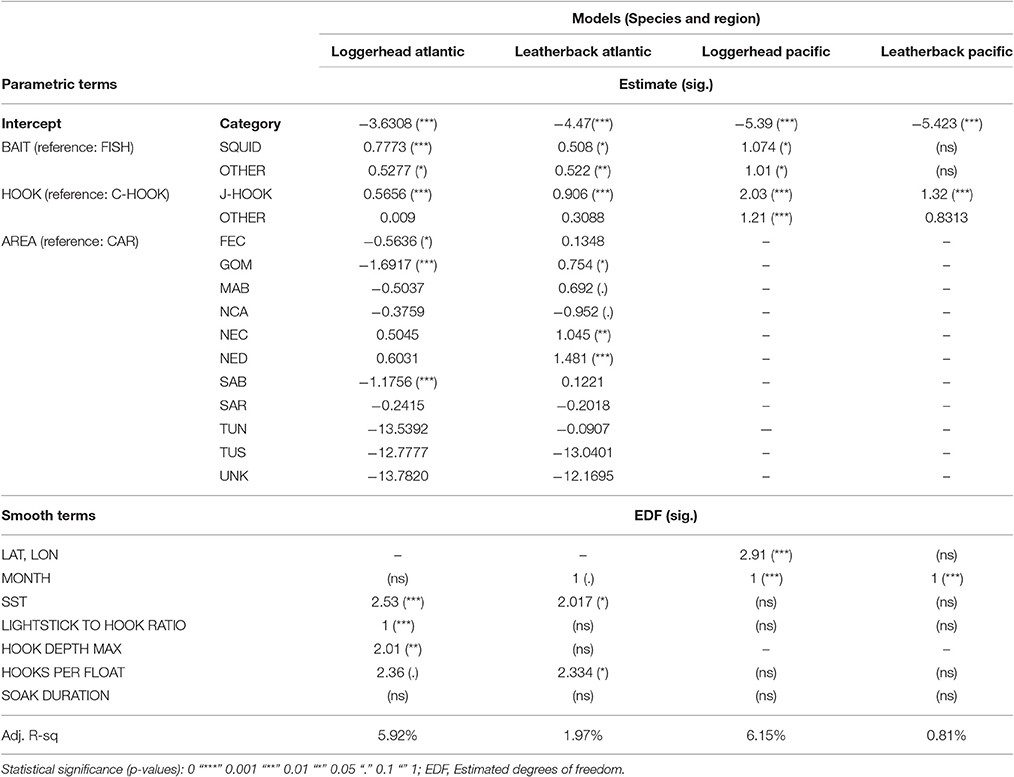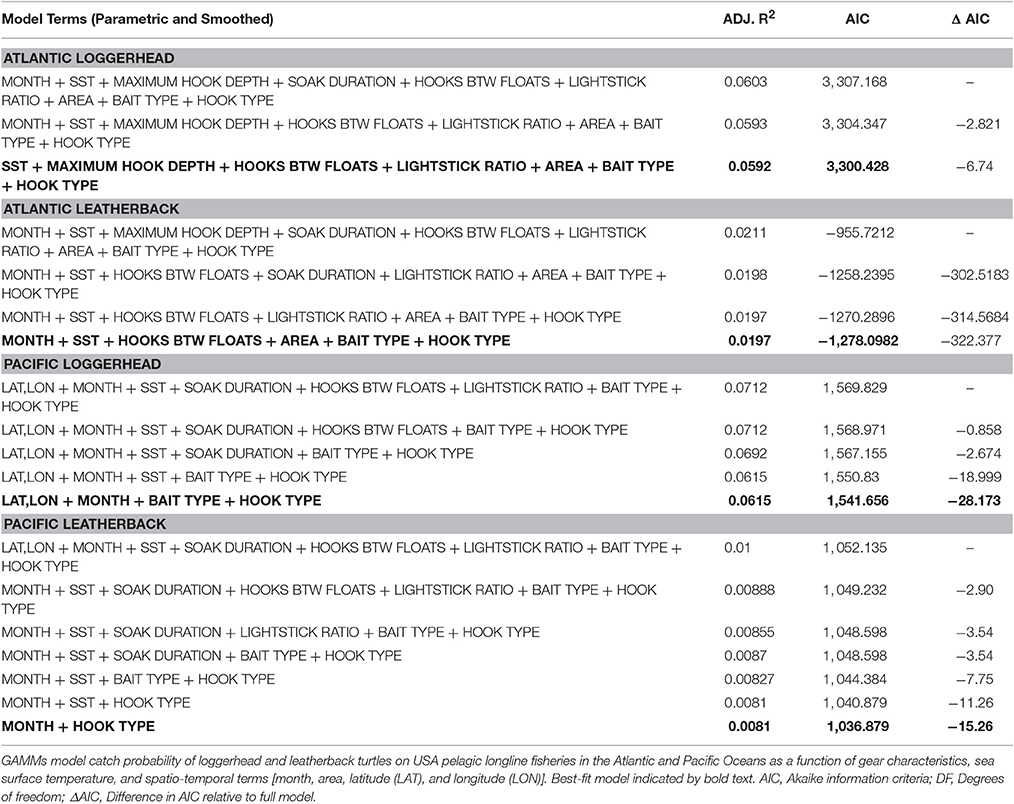Sea Turtle Bycatch Mitigation in U.S. Longline Fisheries
- 1Pacific Islands Fisheries Science Center (NOAA Fisheries), Honolulu, HI, United States
- 2Office of Protected Resources (NOAA Fisheries), Silver Spring, MD, United States
- 3College of Earth, Ocean and Atmospheric Sciences, Oregon State University, Corvallis, OR, United States
- 4Southeast Fisheries Science Center (NOAA Fisheries), Miami, FL, United States
- 5Oceans Program, Leonardo DiCaprio Foundation, Los Angeles, CA, United States
- 6Southeast Fisheries Science Center (NOAA Fisheries), Pascagoula, MS, United States
Capture of sea turtles in longline fisheries has been implicated in population declines of loggerhead (Caretta caretta) and leatherback (Dermochelys coriacea) turtles. Since 2004, United States (U.S.) longline vessels targeting swordfish and tunas in the Pacific and regions in the Atlantic Ocean have operated under extensive fisheries regulations to reduce the capture and mortality of endangered and threatened sea turtles. We analyzed 20+ years of longline observer data from both ocean basins during periods before and after the regulations to assess the effectiveness of the regulations. Using generalized additive mixed models (GAMMs), we investigated relationships between the probability of expected turtle interactions and operational components such as fishing location, hook type, bait type, sea surface temperature, and use of light sticks. GAMMs identified a two to three-fold lower probability of expected capture of loggerhead and leatherback turtle bycatch in the Atlantic and Pacific when circle hooks are used (vs. J hook). Use of fish bait (vs. squid) was also found to significantly reduce the capture probability of loggerheads in both ocean basins, and for leatherbacks in the Atlantic only. Capture probabilities are lowest when using a combination of circle hook and fish bait. Influences of light sticks, hook depth, geographic location, and sea surface temperature are discussed specific to species and regions. Results confirmed that in two U.S.-managed longline fisheries, rates of sea turtle bycatch significantly declined after the regulations. In the Atlantic (all regions), rates declined by 40 and 61% for leatherback and loggerhead turtles, respectively, after the regulations. Within the NED area alone, where additional restrictions include a large circle hook (18/0) and limited use of squid bait, rates declined by 64 and 55% for leatherback and loggerhead turtles, respectively. Gains were even more pronounced for the Pacific shallow set fishery, where mean bycatch rates declined by 84 and 95%, for leatherback and loggerhead turtles, respectively, for the post-regulation period. Similar management approaches could be used within regional fisheries management organizations to reduce capture of sea turtles and to promote sustainable fisheries on a global scale.
Introduction
It is well-established that fisheries bycatch poses a significant threat to numerous sea turtle populations worldwide (Kaplan, 2005; Wallace et al., 2010, 2013). Pelagic longline fishing, a gear type present in all the world's oceans, is directly associated with high rates of bycatch and variable rates of mortality of sea turtles (Camiñas et al., 2006; Swimmer and Gilman, 2012). Sea turtle vulnerabilities to longline fishing gear are dependent on gear configuration as well as the species' geospatial, temporal, and vertical depth distributions (Wallace et al., 2013). Previous assessments of sea turtle bycatch in longline fisheries indicate significantly higher catch rates in fisheries setting gear at shallow depths (<60 m), typically targeting swordfish (Xiphias gladius), compared to most deep-set fishing targeting tuna (Lewison et al., 2004; Kaplan, 2005). Numerous investigations indicate a high percentage of turtles are released alive from shallow-set fishing gear (e.g., Swimmer et al., 2006, 2011, 2013; Piovano et al., 2009; Sales et al., 2010; Swimmer and Gilman, 2012), however a proportion of these turtles are assumed to subsequently die as a result of injuries, with likelihood of mortality a function of anatomical hooking location and degree of gear removal (see Ryder et al., 2006; Carruthers et al., 2009). Mitigating the effects of fisheries bycatch is a conservation priority worldwide, yet both research and managements actions are hindered by statistical challenges when analyzing rare and episodic events, as in common many examples of fisheries bycatch. Despite this, the magnitude of fisheries effort worldwide results in a cumulative negative effect on threatened populations, such as sea turtles, and therefore these challenges must be addressed for effective management.
Commercial longline fishing operations in United States (U.S.) Exclusive Economic Zone are regulated by the National Marine Fisheries Service, which aims to address the conservation needs of highly migratory populations of threatened and endangered marine species such as sea turtles while simultaneously managing domestic fisheries. U.S. fisheries must be in compliance with the Endangered Species Act (ESA) [as amended, 16 U.S.C. 1539(a) (2)] that requires federal agencies to ensure that any action they authorize (such as commercial fisheries), fund or carry out is not likely to jeopardize the continued existence of any endangered or threatened species or result in the destruction or adverse modification of critical habitat of such species. The ESA, in addition to other statutes such as the Magnuson-Stevens Fisheries Conservation and Management Act and the Marine Mammal Protection Act, provide the regulatory regime for U.S. Federal fisheries.
In U.S. waters, pelagic longline fishing (PLL) involves the setting of a mainline to which baited hooks are attached by gangions (or branchlines), occurs in the Atlantic Ocean, Gulf of Mexico and Pacific Ocean. The fisheries in the Atlantic, Caribbean and Gulf of Mexico (herein “Atlantic data”) are managed according to 11 distinct statistical areas (Figure 1). The sea turtle species most commonly captured as bycatch in both ocean basins are leatherback (Dermochelys coriacea) and loggerhead (Caretta caretta) turtles (Witzel, 1999; Lewison et al., 2004; Gilman et al., 2007; Zollett, 2009), both of which are listed on the ESA as either endangered or threatened.
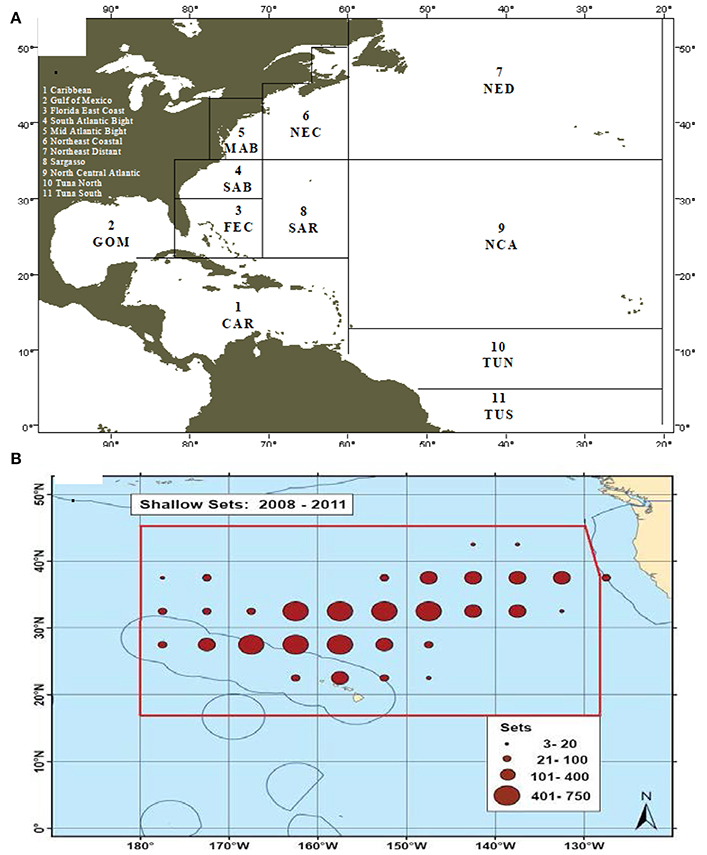
Figure 1. United States (A). Atlantic pelagic longline fisheries statistical reporting areas as recorded by NOAA NMFS Southeast Fisheries Science Center. CAR, Caribbean; GOM, Gulf of Mexico; FEC, Florida East Coast; MAB, Mid-Atlantic Bight; NCA, North Central Atlantic; NEC, Northeast Coastal; NED, Northeast Distant; SAB, South Atlantic Bight; SAR, Sargasso; TUN, Tuna North and TUS, Tuna South. (B) Location of shallow sets made by the Hawaii shallow-set longline fishery from 2008 to 2011 (source: NOAA Fisheries Pacific Islands Regional Office).
Starting in 2000, the Northeast Distant (NED) statistical area (8.9 million km2) of the U.S. Atlantic PLL fishery, a highly productive area that includes the Grand Banks, was partially closed and then fully closed in 2001 in response to legal action aimed to reduce bycatch of endangered sea turtles (July 6, 2004, 69 FR 40734; U.S Dept. of Commerce, 2001; NMFS, 2004b). The NED portion of the Atlantic is primarily a swordfish-targeted fishery and was previously determined to have high rates of sea turtle bycatch (Witzel, 1999). Around the same time, in the U.S. North Pacific PLL fishery, the fishing grounds north of Hawaii (north of 28°N and between 150 and 168°W) were partially closed beginning in December 1999, and the entire longline swordfish fishery was closed in 2001 due to sea turtle bycatch. Beginning in April 2001, a spatial and seasonal closure off the U.S. North Pacific PLL fishing grounds south of 15°N during April-May was also implemented (NMFS, 2004a,b).
These temporary fisheries closures in both the Atlantic and Pacific Oceans lasted for ~3 years. During this time, U.S. government-sponsored research was conducted in the NED that provided evidence that the use of a relatively large (18/0) circle hook in combination with ~200–500 g Atlantic mackerel (Scomber scombrus) bait could significantly reduce bycatch rates of both loggerhead and leatherback sea turtles (Watson et al., 2005). Additionally, hook-and-bait combinations were also found to decrease the proportion of deeply ingested hooks in loggerhead turtles (Watson et al., 2005), thereby presumably increasing the rates of post-interaction survival. Based on these findings, both previously closed areas in the North Pacific and NED area of the Atlantic were re-opened with required use of circle hooks with minimum width dimensions equivalent to an 18/0 size hook (~4.9 cm). In the Hawaii shallow-set-permitted fishery, bait type is limited to fish-only, whereas in the NED bait type allowances are made for use of squid bait in addition to fish bait. In both regions, additional regulations also included variations of limited entry and fishing effort, turtle bycatch limits, requirements for sea turtle education and outreach efforts, as well as increased on-board scientific observer coverage [NOAA, 50 CFR Part 660 (Pacific); NOAA 50 CFR Parts 223 and 635 (Atlantic)].
In this investigation, we used long-term fisheries observer data to assess the efficacy of regulatory measures on the probability of sea turtle bycatch in two U.S. pelagic longline fisheries. Specifically, we tested the null hypothesis that bycatch per unit effort (BPUE) was the same before and after regulations. Additionally, we used various statistical models to identify explanatory variables associated with the probability of sea turtle bycatch in both ocean basins, thereby providing further insight into the regulatory measures as well as new information on turtle species' vulnerabilities and responses to specific mitigation methods.
Methods
Data Sources
Observer data for the analysis originated from the Pelagic Observer Program (POP) and the Longline Observer Data System for the Atlantic and North Pacific, respectively. POP data are maintained by the NMFS Southeast Fisheries Science Center and have been previously described (Keene, 2016). For use in this study, POP data were limited to trips that targeted both swordfish and a mix of swordfish and tunas from 1992 to early 2015, which were analyzed jointly. These analyses omitted data from experimental operations when vessels used modified gear to test various outcomes (e.g., during the NED closure from 2001 to 2003). Pre-regulation data are defined as years 1992–2001, and post-regulation data start in mid 2004 after the fishery was re-opened. These data were combined and analyzed jointly. Observer coverage varied during this time, ranging between ~3 and 5% of total fleet effort from 1992 to 2003 (Beerkircher et al., 2002) followed by a mandated minimum 8% coverage of the fleet beginning in 2004 (NMFS, 2004b).
The NMFS Pacific Islands Fisheries Regional Office maintains the Pacific observer data. Pacific data analysis was limited to the specified shallow-set (swordfish-target) sector of the fishery from 1994 to 2014. Pre-regulation data include data prior to February 2002, and the post-regulation period after May 2004. Between 1994 and 2000, observer coverage ranged from 3 to 10% (mean ~5%) and increased to 20.5% in 2001. Observer coverage became mandatory (100% coverage) for all Hawaii-permitted pelagic longline vessels targeting swordfish since the fishery re-opened.
Data Caveats
General observer data characteristics and turtle bycatch specific to the different targeted sets from the Atlantic and Pacific Oceans are in Table 1. For both combined Atlantic and Pacific data, the number of observed sets analyzed is heavily skewed post-regulation vs. pre-regulation, which is a function of the mandated increased observer coverage when the fisheries were re-opened in 2004. For all data, nominal bycatch per unit effort (BPUE) was calculated as individual loggerhead and leatherback turtles caught for each unique set per 1,000 hooks. In certain situations, we collapsed categorical variables to achieve sufficient sample sizes and statistical rigor (see Table 2). Turtle size measurements are only available for loggerheads, as leatherback turtles were not boarded due to their size.
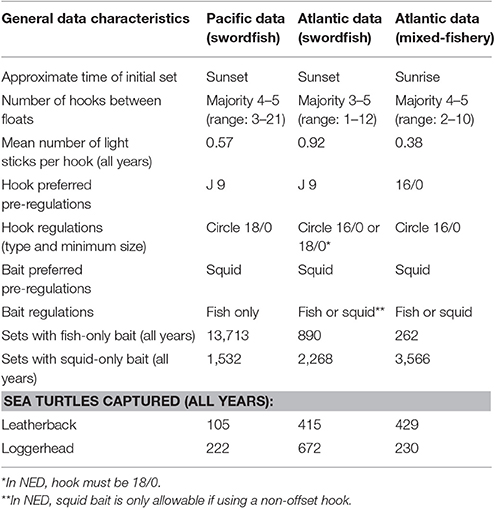
Table 1. General characteristics and sample sizes for observer data from the Pacific Hawaii-based shallow-set longline fishery, the Atlantic swordfish-set longline fishery, and Atlantic mixed-set longline fishery from ~1992 to 2014.
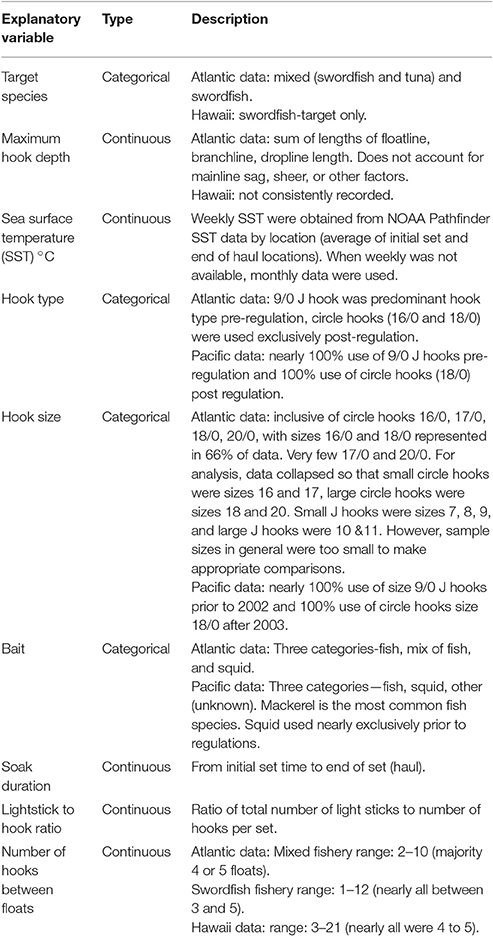
Table 2. List of explanatory variables for Atlantic and Pacific observer data used in generalized additive mixed models.
Analysis of sea surface temperature (SST) data obtained from both regions indicated a high degree of discrepancies when compared with satellite-derived data at a slightly broader scale and time span encompassing fishing location coordinates. This is largely due to the frequent collection of SST using unstandardized methods. Based on these findings, our statistical analyses included SST data derived from 5-day composites from AVHRR Pathfinder v4.1 (1985–2003). These SST data were continued by the AVHRR Global Area Coverage dataset (January 2003–April 2016) with a spatial resolution of 0.1° × 0.1°. Analyses included the weekly values when available, otherwise monthly data were used.
Analytical Methods
All analyses were conducted separately for the two regional data sets (Atlantic and Pacific) as well for each turtle species, leatherback, and loggerhead. On a few occasions, a subset of the Atlantic data, specifically the NED region, was analyzed separately given the enhanced regulatory requirements in this area (e.g., 18/0 circle hook). Turtle catch probability was uniquely referenced at the level of longline set, which refers to the individual mainline set (or haul) with baited hooks that remain soaking in the water for ~8–12 h. Spatial statistics were used to generate spatio-temporal kernel density maps to visualize longline sets that captured one or more turtles. Finally, we used statistical models that incorporated a suite of variables that help explain and predict the probability of sea turtle bycatch on longline fishing vessels in the U.S. Atlantic and Pacific fleets.
Assessment of Regulations
In order to assess the efficacy of the conservation measures as a whole, we used non-parametric statistics (Mann-Whitney, due to lack of normality and homogeneity of the variances) to test the null hypothesis that sea turtle BPUE was similar before and after the regulations in mid 2004. Specifically, we compared BPUE for time periods before and after the regulations for leatherback and loggerhead turtles in the Atlantic and Pacific.
Identification of Spatio-Temporal Bycatch Patterns
Spatial kernel density maps were created for the locations of fishing effort and sets with turtle bycatch (>0) using the “kde2d” function in the “MASS” package in R (v.3.3.1).
Generalized Additive Mixed Models to Determine Probability of Turtle Bycatch
Longline observer data were analyzed to determine the probability of catching leatherback and loggerhead sea turtles using binomial GAMMs. We modeled the presence or absence of either sea turtle species within a single longline set. GAMMs are a non-linear regression technique in which the relationships between the dependent and the independent variables are modeled with non-parametric smooth functions and make allowances for complex relationships (Hastie and Tibshirani, 1990; Wood, 2006). A random intercept mixed models was used with individual vessel ID to account for repeated longline trips by individual vessels.
Species (leatherback, loggerhead) and region-specific (Atlantic, Pacific) full models were constructed that had the following generalized relationship (Equation 1). Specifically, given a dependent variable y and a set of x independent covariates, the relationship between them is established by:
The dependent term (y) in our models was binomial set data (0 = no turtle caught on a set; 1 = one or more turtles caught per set) and was modeled with a logit link function (Wood, 2006). αi is the variance component around α associated with the vessel effect, gi are one-dimensional cubic spline smoothing functions for each independent continuous covariates, xij were independent covariates that included distinct variable combinations dependent on region. Full species-specific models in both regions included independent covariates described in Table 2 and Table A1. All models met the assumptions of constant variance and normal residuals.
Year as a variable was confounded with gear changes and thus omitted from the models. Maximum hook depth [sum of gangions (branchlines), droplines, and leaders] was only recorded by observers in the Atlantic and thus was not included in Pacific models. Additional predictor variables used in all full models included month, SST, bait type (categories: squid, fish, other), hook type (circle, J, other), light stick to hook ratio, soak duration of gear, and number of hooks between floats. Hook size, bait size, or hook offset were not analyzed due to limited sample sizes before and after regulations. A backward selection approach was used to identify the best model. We determined the best-fit models by minimizing the Akaike Information Criterion (AIC). Model selection Appendix and terms specific to turtle species and region are outlined in Table 2. All GAMM analyses were carried out using the “mgcv” package in R (v. 3.3.1).
Results
Descriptive Summary of Atlantic Sea Turtle Bycatch Data
In total, Atlantic data in our analyses included 11,982 unique sets conducted on 1,762 trips from an approximately equal number of swordfish and mixed target trips. Throughout the 1992–2015 period, 844 leatherback and 902 loggerhead turtles were captured. Turtle bycatch per unit effort (BPUE; # individuals caught per 1,000 hooks, ±SD) rates in each of the statistical reporting areas within the Atlantic PLL fishery for all the years are reported (Figure 2), with clear distinction of the NED region, which had the highest turtle BPUE of any statistical reporting area within the Atlantic PLL fishery. BPUE tended to be higher for years prior to 2001. Bycatch rates are reported by year for all areas combined in Figure 3.
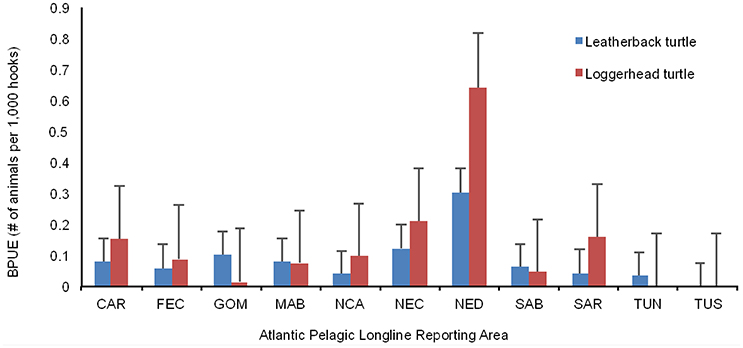
Figure 2. Atlantic data. Mean turtle BPUE (# individuals caugh per 1,000 hooks ±SD) by statistical reporting area. CAR, Caribbean; GOM, Gulf of Mexico; FEC, Florida East Coast; MAB, Mid-Atlantic Bright; NCA, North Central Atlantic; NEC, Northeast Coastal; NED, Northeast Distant; SAB, South Atlantic Bight; SAR Sargasso; TUN, Tuna North and TUS, Tuna South.
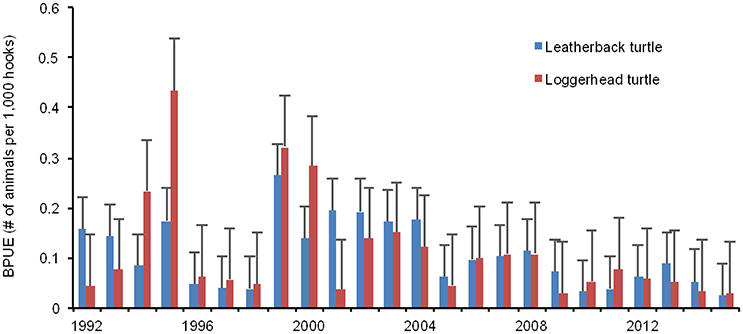
Figure 3. Atlantic data Sea turtle bycatch per unit effort (BPUE, #individuals caught per 1,000 hooks, ±SD) by year.
Ninety-four percent (94%) of all Atlantic sets showed zero leatherback turtles recorded. A single leatherback was caught on 611 sets, 2 or 3 were caught on 92 sets, and between 4 and 7 were caught on 6 sets. Ninety-five percent (95%) of sets showed zero loggerhead turtles recorded. A single loggerhead turtle was captured on 482 different sets, between 2 to 4 were caught on 87 sets, between 5 to 7 were caught on 12 sets, and between 9 to 12 were caught on 5 sets. Mean curved carapace length (CCL, cm) for loggerhead turtles brought on board was 73.3 cm (SD = 27.6).
Descriptive Summary of Pacific Sea Turtle Bycatch Data
Pacific observer records were from 15,472 sets from 460 unique trips during 1994–2014, which included observed capture of 105 leatherback and 222 loggerhead turtles (Figure 4). Ninety-nine percent (99%) of sets had zero leatherback turtles recorded. A single leatherback was caught on 103 sets and 2 were caught on 2 sets. Ninety-nine percent (99%) of sets had zero loggerhead turtles recorded. A single loggerhead was caught on 197 sets and 2 or 3 were caught on 25 sets. Mean CCL for all turtles brought on board was 62.8 cm (SD = 11.6), which is smaller than loggerheads measured in the Atlantic (CCL; mean = 73 cm, SD ± 27.8, Figure 5). Overall, the range of sizes for loggerhead turtles in the Atlantic was considerably broader than in the Pacific.
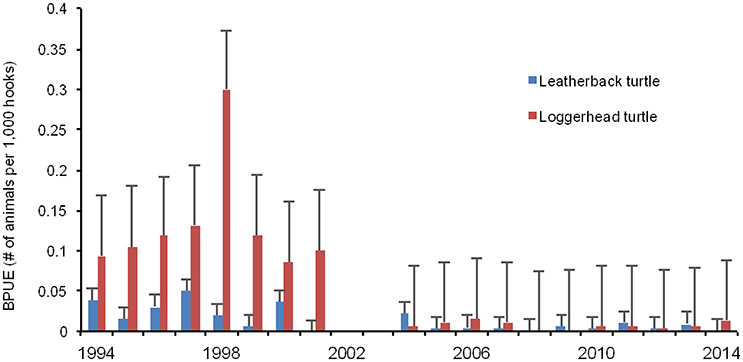
Figure 4. Leatherback and loggerhead BPUE (# individuals caught per 1,000 hooks, ±SD) for Hawaii-permitted shallow set longline fishery by year.

Figure 5. Frequency of sets that caught loggerhead and leatherback turtles by set sea surface temperatures (SST) in the Atlantic (A) and Pacific (B). Size frequency of loggerhead turtles captured in longline sets in the Atlantic (C) and Pacific (D). Dots in paragraphs indicate mean and lines indicate median. Loggerhead turtle measurements in curved carapace length(CCL, cm).
Frequency of Capture as a Function of Turtle Size and Sea Surface Temperature
In the Atlantic, the frequency of sets with bycatch in our study was highest within an approximate SST range between 22 to 26°C and 23 to 27°C for loggerheads and leatherbacks, respectively. In the Pacific, the peak range of SST with positive sea turtle captures occurred between 17 and 19°C for both loggerheads and leatherbacks (Figure 5).
Comparison of Bycatch before and after the Regulations
For Atlantic observer data inclusive of all reporting areas, bycatch rates of leatherback and loggerhead turtles were significantly lower during the post-regulation period, a reduction of 40 and 61%, respectively. Within the NED area alone, which had greater mitigation requirements than the rest of the Atlantic areas, turtle bycatch rates were further reduced during the post-regulation period, by 64 and 55% for leatherback and loggerhead turtles, respectively. For Pacific data, turtle bycatch rates were significantly lower during the post-regulation period, a reduction of 84 and 95% for leatherback and loggerhead turtles, respectively (Table 3).
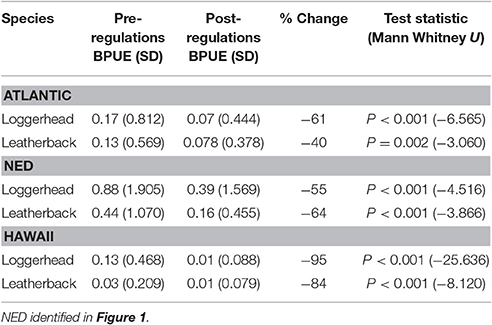
Table 3. Observer sampled nominal mean bycatch per unit effort (BPUE, per thousand hooks) before and after regulations by species by region.
Spatio-Temporal Sea Turtle Bycatch Patterns
Kernel density plots illustrate the distribution of observed longline sets with bycatch of at least one sea turtle by quarter for both the Atlantic and Pacific (Figure 6). Spatial and temporal patterns are fishery-dependent and largely driven by the distribution of fishing effort. In the Atlantic, longline sets that captured one or more turtles were most dense in southern latitudes during quarters 1 and 2 and shift northeast to the NED area in quarters 3 and 4. Sets with loggerhead turtle captures in the Gulf of Mexico (GOM) were most prevalent during quarter 2, whereas sets with leatherback turtles were most frequent in the GOM during quarters 1 and 2. Longline sets with leatherback turtles were most dense in the NED and coastal northern U.S. waters during quarters 3 and 4. Sets with loggerhead turtles in the Pacific observer data had less clear patterns, with the exception of a high density of sets with loggerhead turtles in quarter 1 northeast of the main Hawaiian Islands. Similarly, sets with leatherback turtle interactions were most dense north of the main Hawaiian Islands during quarters 1 and 2, with density shifted further west during quarter 3.
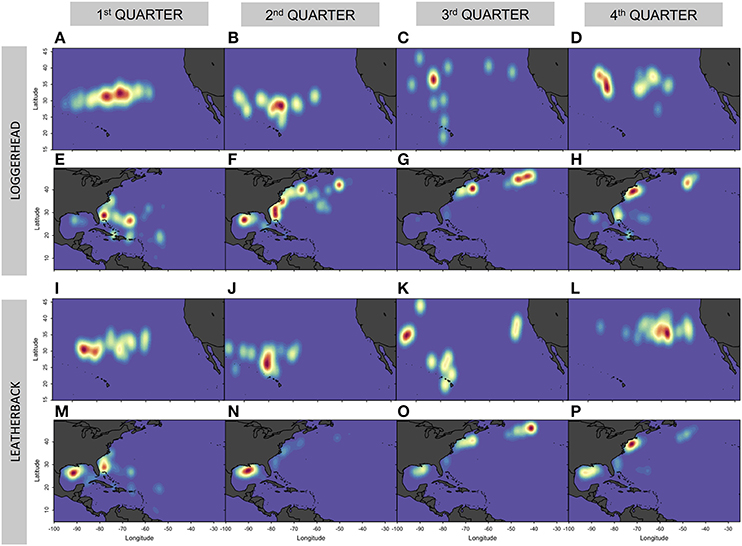
Figure 6. Spatial kernel density plots of loggerhead (top, upper figure) and leatherback (bottom, upper figure) turtle captures by area and quarter from Atlantic observer data. Spatial kernel density plots of loggerhead (top, lower figure) and leatherback (bottom, lower figure) turtle captures by quarter from Hawaii observer data. Loggerhead turtle plots (A–D) are 1st through 4th quarter in Pacific and (E–H) are 1st through 4th quarter in the Atlantic. Leatherback turtle plots (I–L) are 1st through 4th quarter in in the Pacific and (M–P) are 1st through 4th quarter in the Atlantic.
Model Outputs and Relative Probabilities of Capture
The best-fit models with the final terms for each species and region are summarized in Appendix. Turtle bycatch probabilities as a function of significant terms in the model are shown in Figure 7. Model estimates of the individual variable effects on bycatch probability for all years of data collections are in Table 4. Both absolute and relative probabilities of bycatch for both leatherback and loggerhead turtles in the Atlantic and Pacific were determined using the rescaled GAMM model (Table 5). Since probabilities differed among the various statistical reporting areas of the Atlantic, we report on gear comparisons for the area of the NED given the enhanced regulatory requirements in this region and allowing for more valuable comparisons relative to sea turtle bycatch probability as a function of hooks and bait combinations. Bycatch probabilities are also reported for other statistical reporting areas in the rest of the Atlantic for circle hooks with fish bait (Table 5).
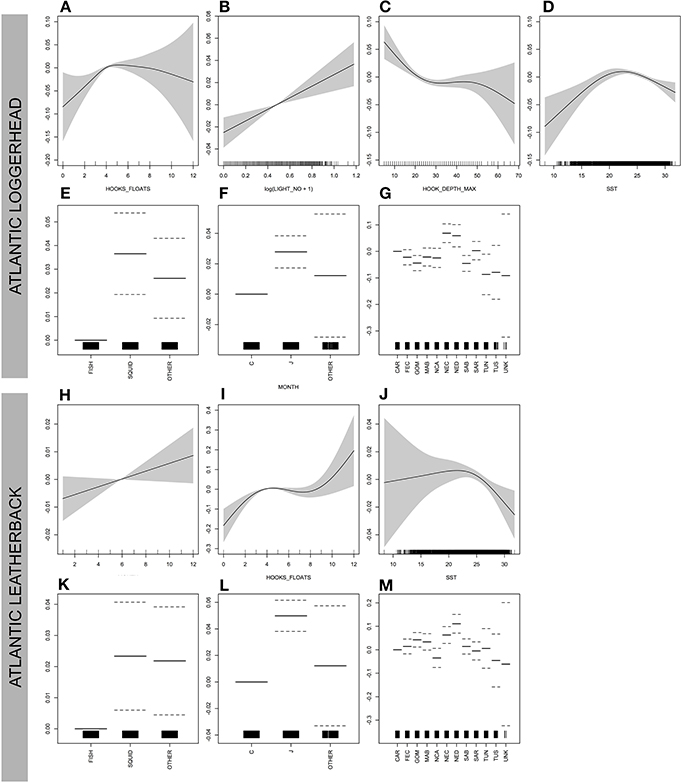
Figure 7. Effect of gear characteristics and weekly averaged satellite derived sea surface temperature (wSST) on catch probability of loggerhead (A–G) and leatherbacks in the Atlantic Ocean (H–M). The y-axis is in logit units and represents deviation from the logit mean. The smoothed probability of catch is scaled by its coefficient from the Generalized Additive Mixed Model (GAMM) model. The shaded area represents the upper and lower twice-standard-error curves. For factors (categorical variables), solid lines are the mean and the first factor is the reference group centered at zero, dashed lines represent upper and lower twice-standard errors. Positive (negative) values represent higher (lower) probability of catch from the mean capture probability. Vertical ticks on the x-axis indicate data distribution. For the Atlantic, the probability of loggerhead turtle capture is a function of (A) number of hooks between floats,(B) ratio of light sticks to hooks (log scale due to improve model fit), (C) maximum reported hook depth, (D) SST, (E) Bait type, (F) Hook Type, (G) Statistical Reporting, area. For the Atlantic, the probability of leatherback turtle capture is functional of (H) Month, (I) Number of hooks between floats, (J), SST, (K) Bait Type, (L) Hook Type, (M) Statistical Reporting area.
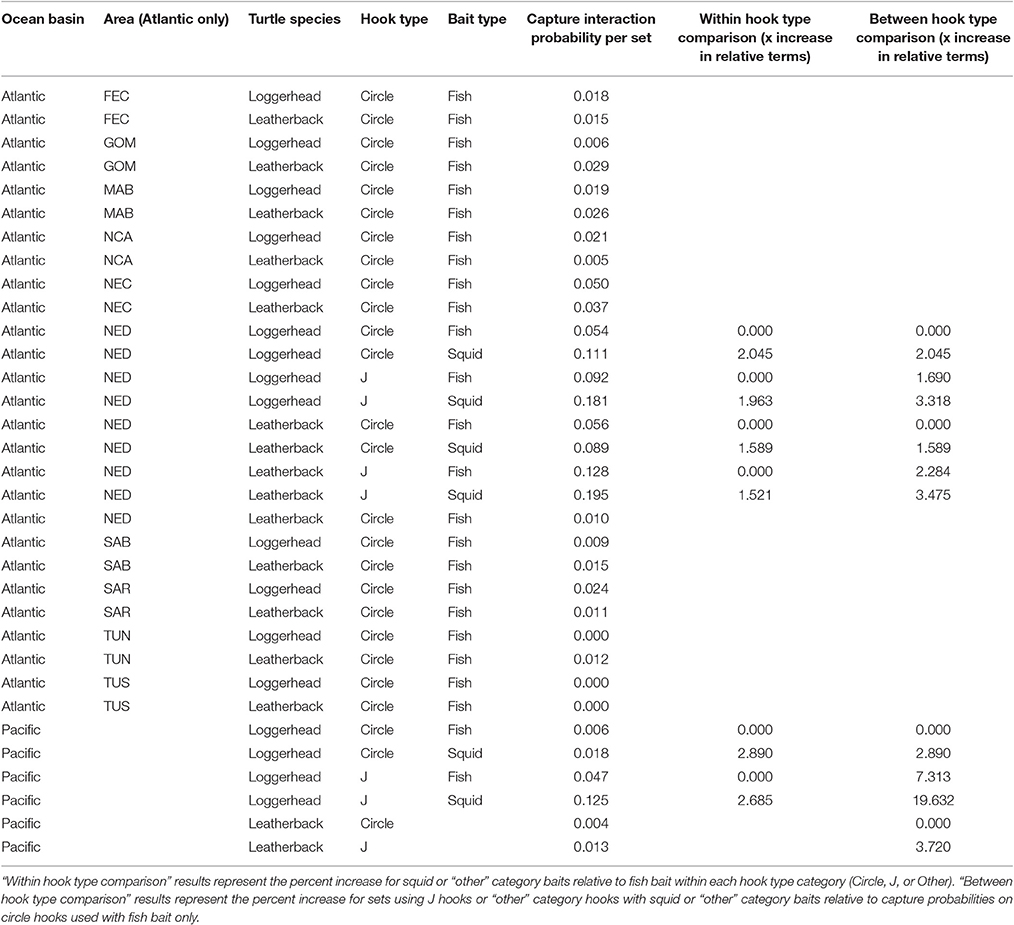
Table 5. Capture probabilities of leatherback and loggerhead sea turtles from GAMM models and associated absolute and relative increases in the Atlantic or Pacific Oceans by longline sets for combinations of hook type, bait, and area.
Probabilities of Turtle Capture
Loggerhead Bycatch in the Atlantic Ocean
The factors found to influence the capture of loggerhead turtles in the Atlantic are number of hooks between floats, ratio of light sticks to hooks, SST, bait type, hook type, and fishing area (Figures 7A–G; Table 1A). Probability of loggerhead bycatch is expected when the number of hooks between floats is 4 or 5, with light sticks attached at each hook, and when maximum estimated hook depth is ~22 m or less. The GAMM identified an increased loggerhead catch probability with SST between ~18 and 24°C. Plots of factors such as bait and hook type indicate loggerhead turtle bycatch probability is lowest when using only fish bait, and significantly increased when using squid bait. The use of J hooks results in significantly elevated bycatch probability as compared to circle hooks for the combined Atlantic statistical areas.
In regards to fishing location in the Atlantic, GAMMs identified the expected probability of catching a loggerhead is highest in the NED and NEC when using circle hooks and fish bait (Table 5). The expected probability of catching a loggerhead turtle on a set in the NED area using circle hooks and fish bait is 0.054 as compared to 0.111 if using circle hooks and squid bait, indicating a two-times (2.045) greater catch probability of a loggerhead using squid bait compared to fish bait. There is a reported 1.690 times greater catch probability of catching loggerhead turtles in the NED using J hooks with fish bait compared to using circle hooks with fish bait. In combination, there is a predicted 3.318 times greater catch probability of loggerhead turtles in the NED using the J hooks with squid bait as compared to circle hooks with fish bait (Table 5).
Leatherback Bycatch in the Atlantic
Based on the GAMM models, the expected probability of catching a leatherback turtle in the Atlantic Ocean is most influenced by month, number of hooks between floats, SST, bait type, hook type, and statistical reporting area (Figures 7H–M, Table 5). Bycatch probability is elevated during the months of October through December and within SST in the range of 18–24°C. Leatherback turtle bycatch probability is expected to be lowest when using only fish bait and circle hooks (measured separately) and significantly increases when using squid and J hooks (Table 1A). There is a significant elevated bycatch probability of leatherback turtles in the GOM, NEC, and NED regions of the Atlantic statistical reporting area. The probability of catching a leatherback turtle per set in the NED area of the Atlantic while using circle hooks and fish bait is 0.056 as compared to 0.089 if using circle hooks and squid bait, indicating a 1.589 times greater catch probability of leatherback turtles by using squid (vs. fish) bait. When bait is held constant, there is a 2.284 times greater catch probability of leatherback turtles in the NED using fish bait using J hooks as compared to using circle hooks. There is a 3.475 times greater catch probability of leatherback in the NED using the combination of J hooks with squid bait vs. circle hooks with fish bait (Table 5).
Loggerhead Bycatch in the Pacific (Hawaii Shallow Set Fishery)
The key variables influencing the probability of loggerhead bycatch in the Pacific include month, bait type, hook type and location (Figures 8A–D, Table 4). Loggerhead bycatch is expected to be highest during January and February and in two geographic locations (Figure 8D). Loggerhead turtle bycatch probability is lowest with use of fish bait (vs. squid or other) and circle hook (vs. J or other). GAMM results indicate the probability of loggerhead turtle catch in the Pacific is a predicted 2.890 times higher when using circle hooks with squid bait as compared to when using circle hooks with fish bait (0.018 vs. 0.006). There was a predicted 7.313 times greater catch probability of loggerheads using J hooks and fish bait as compared to circle hooks and fish bait. In combination, there is an expected 19.632 times greater catch probability when using the combination of J hooks with squid bait as compared to circle hooks with fish bait (Table 5).
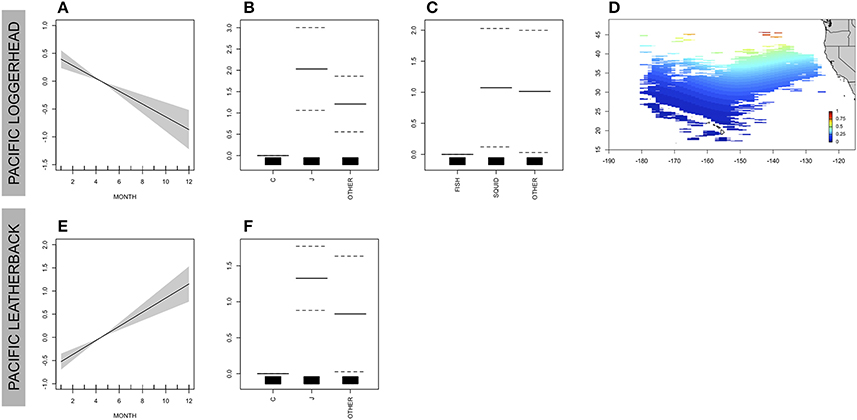
Figure 8. Effect of gear characteristicsand location on the probability of catch of loggerheads (A–D) and leatherbacks (E,F) in the Pacific. The y-axis is in logit units and represents deviation from the logit mean. The smoothed probability of capture is scaled by its coefficient from the Generalized Additive Mixed Model (GAMM) model. The shaded area represents the upper and lower twice-standard-error curves. For factors, solid lines are the mean and the first factor is the reference group centered at zero, dashed lines represent upper and lower twice-standard errors. Positive (negative) values represent higher (lower) probability of catch from the mean capture probability. Vertical ticks on the x-axis indicate data distribution. For the Pacific, the probability of loggerhead turtle capture is a function of (A) Month, (B) Hook Type, (C) Bait Type, (D) Location (scaled between 0 and 1 catch probability). For the Pacific, the probability of leatherback turtle capture is a function of (E) Month, and (F) Hook Type.
Leatherback Bycatch in the Pacific (Hawaii Shallow Set Fishery)
Variables there were expected to influence the probability of leatherback turtle capture in the Pacific include month and hook type (Figures 8E, F, Table 4). GAMM results indicate a 3.72 times greater catch probability of leatherback turtles on J hooks vs. circle hooks (0.013 vs. 0.004; Table 5). Simultaneous gear changes due to regulatory measures limited additional comparisons.
Discussion
Value of Statistical Models for Bycatch Prediction
In this study, we used statistical models that allow for non-linear relationships (Hastie and Tibshirani, 1990; Guisan et al., 2002) and are thus highly suitable for modeling rare bycatch events, such as sea turtle bycatch in longline fisheries (McCracken, 2004; Coelho et al., 2013). Statistical models, such as GAMs and their extension the GAMMs, have been used extensively in marine fisheries research and management to forecast outcomes such as target species abundance, catch levels, etc. (Walsh and Kleiber, 2001). GAMs can also be used to identify species' associations with environmental variables, such as SST and depth, and therefore be valuable to predict the likelihood that a given species would inhabit or be captured in a particular environment (Forney et al., 2015). Using models to predict the probability of a relatively rare event, such as fisheries bycatch or ship strikes, is challenging due to a high proportion of zero captures resulting in a skewed distribution (Martin et al., 2015). In spite of the many challenges, recent modeling efforts have provided critical information with direct value to protected species management. Examples are numerous and across taxa, including seabirds (Majluf et al., 2002; Winter et al., 2011; Gilman et al., 2016a), marine mammals (Majluf et al., 2002; Orphanides, 2009; Redfern et al., 2013; Martin et al., 2015), sharks (Walsh and Kleiber, 2001; Minami et al., 2007), and sea turtles (Murray, 2009, 2011).
GAMMs in this study resulted in the highest explanatory power for the probability of bycatch of loggerhead turtles in the Pacific, with the least explanatory ability for leatherback bycatch in the Atlantic. In general, much of the expected bycatch probability for both turtle species was explained in time and space, which is largely a function of the fishery effort and the overlap between target species and sea turtle foraging habitats. Given the fishery-dependent nature of these data, there is no way to isolate the bycatch probability independent from the fishing effort, especially as it relates to space and time. However, these analysis incorporates additional characteristics of the operational components of the fishery including gear specifications such as hook and bait type and approximate hook depth that can provide insights on ways to decrease sea turtle bycatch probability within a specific region during normal fishing operations. As our primary goal was to understand the effects gear differences and spatio-temporal terms have on bycatch probability, we focused on these covariates in the models and their resultant statistical estimates and significance. Despite the potential importance to turtles' presence in a given location, habitat variables, such as fronts, eddies, and primary productivity, were not included in modeling efforts. We acknowledge, that inclusion of these variables might have improved model fit (adjusted R2) by explaining the oceanographic context surrounding each longline set.
Interpretation of Findings
Spatial Distribution and SST
Using all Atlantic data, we modeled the probability of turtle bycatch as a function of location (statistical reporting areas) and identified an elevated bycatch risk in the NED and NEC for loggerhead turtles and in the NED for leatherbacks. This finding was expected as the NED is primarily a swordfish-targeting region where hooks are set shallow at night with a high light stick-to-hook ratio that results in a combination of variables associated with an increased probability of catching primarily loggerhead turtles according to our models.
Similar to previous studies, our results identified the influential role of SST regarding the probability of catching loggerhead and leatherback turtles in both the Atlantic and Pacific oceans. In general, there is a broader range of temperatures recorded in the Atlantic (~10–30°C) vs. Pacific data (~16–26°C), due to the fact that US fleets operate over a wider latitudinal range in the Atlantic than the Pacific. The frequency of sets with sea turtle bycatch in the Atlantic was highest within approximate SST ranges between 22°C to 26°C and 23°C to 27°C for loggerheads and leatherbacks, respectively. These ranges are nearly identical to those previously reported (Watson et al., 2005; Brazner and McMillan, 2008; Foster et al., 2012; Huang, 2015). The range of SST with positive sea turtle captures was more protracted in the Pacific, with the frequency of sets with sea turtle bycatch highest when SST ranged between ~17 and 19°C for both loggerheads and leatherbacks. These ranges overlap entirely with the species' at-capture peak SST ranges previously reported in the North Pacific (Howell et al., 2008, 2015; Kobayashi et al., 2008; Abecassis et al., 2013).
SST has been previously identified as a strong predictor of sea turtle movements (Kobayashi et al., 2008; Mansfield et al., 2009), and thus SST can serve a valuable role as a means to reduce sea turtle bycatch. For pelagic longline fisheries operating in the north Atlantic, Brazner and McMillan (2008) investigated the frequency of loggerhead turtle capture as a function of SST and suggested limiting fishing activity in SST >20°C to minimize loggerhead bycatch. In the North Pacific, Howell et al. (2008, 2015) used extensive satellite tracking data to identify oceanographic features such as SST that could be used to predict the presence of loggerhead and leatherback turtles with the ultimate goal to develop a means to reduce sea turtle captures in longline fisheries. The result is an internet-based product, NOAA TurtleWatch (www.pifsc.noaa.gov/eod/turtlewatch.php), that serves to provide information on preferred sea turtle habitat, specifically SST, that can be used by managers and fishers to make dynamic decisions to reduce the incidental capture of loggerhead and leatherback turtles during longline fishing operations (Howell et al., 2008, 2015). This is particularly valuable in the shallow-set sector of the Hawaii fishery that operates under sea turtle bycatch limits, whereby the fishery is mandated to immediately cease fishing operations until the remainder of the calendar year once a certain number of turtle interactions by species occurs. Howell et al. (2015) proposed a dynamic management concept based upon a SST habitat boundary, whereby fishing effort should be avoided in the SST range of 17.0–18.5°C to minimize interactions with both loggerheads and leatherbacks. In calculating the potential impact of this restriction on the Pacific observer data presented herein, the observed number of turtles captured would have been reduced by 94 (42%) loggerhead turtles and 46 (44%) leatherback turtles.
The Role of Bait in Bycatch
Our findings on the significance of bait type influencing the probability of capturing sea turtles are consistent with other experiments conducted in the Atlantic, whereby it was determined that the largest reduction in (primarily leatherback) turtle bycatch was achieved with use of fish bait, specifically mackerel (Watson et al., 2005; Santos et al., 2012). Based on results of numerous investigations, there is general consensus that replacing squid bait with fish bait will reduce sea turtle bycatch. However, regulations requiring use of fish bait to reduce sea turtle bycatch must be balanced against the potential target species catch loss, a concern that has been previously evaluated (Watson et al., 2005; Yokota et al., 2009; Curran and Bigelow, 2011; Coelho et al., 2012). Further, bait choice can also potentially increase bycatch of certain sharks or other vulnerable species (Foster et al., 2012; Santos et al., 2012; Gilman et al., 2016b). As with other bycatch reduction techniques, success in adopting these measures may be fishery dependent. Among the factors that need to be evaluated include the target species, bait, hook type, and intended hook depth, the species and life-stage of bycaught turtles, fishing area (which is co-related with SST) and season, and other bycatch species potentially affected. In the U.S. Atlantic longline fishery, NED fishers have the choice to use fish or squid bait, yet if they use squid it must be accompanied by a circle hook (18/0) with no offset. It is clear that mandated use of fish bait in all areas would lead to further reductions in sea turtle bycatch.
Ratio of Light-Sticks to Hooks
Unlike leatherback turtles that are primarily externally hooked in the armpit, shoulder or flipper, loggerhead turtles are primarily captured as a result of actively biting and/or swallowing a baited hook (Watson et al., 2005). Based on these observations, Watson et al. (2005) proposed the potential attraction to light sticks, or phototaxis, as an explanation of loggerhead turtle bycatch rates in longline gear. Despite the interest to investigate the role of lights in sea turtle bycatch, such analysis was not possible in the previous NED experiments given that this variable remained constant throughout the time-series. In this study, with data from both swordfish-target and mixed-target sets, variation existed in operational factors such as ratio of lightsticks deployed per hook, whereby lights are generally placed near each hook on swordfish-style sets and likely every other hook in a mixed target set. This overlap allowed for further exploration on the role of lightstick use on the probability of turtle capture. This study identified a positive linear relationship regarding loggerhead turtle bycatch probability and lightstick use. Based on earlier speculations of the role of lightsticks in attracting sea turtles to longline fishing gear, Wang et al. (2007) conducted behavioral experiments with captive loggerhead turtles using an orientation arena to conclude that lightsticks of varying wavelengths significantly attract turtles. These results from the GAMMs, in combination with the laboratory studies (Wang et al., 2007), provide evidence that loggerhead turtles are drawn to the vicinity of longline gear (baited hooks) with increased illumination. Additional bycatch reduction may be gained for loggerhead turtles by reducing or eliminating the use of lightsticks in longline gear.
Hook Type
In all models there was a significant lower probability of bycatch with circle hooks compared to J hooks. The finding of reduced probability of sea turtle bycatch on circle hooks is consistent with a number of different studies and has been thoroughly discussed (Watson et al., 2005; Yokota et al., 2009; Curran and Bigelow, 2011; Santos et al., 2012; Serafy et al., 2012).
Hook Depth
Estimates of theoretical hook depths can be inferred using information on gear characteristics, such as the length of the longline, number of hooks between floats and catenary geometry; however the actual hook depths may be shallower due to shoaling by environmental factors (Bigelow et al., 2006). In this study, two variables serve as a proxy for hook depth: maximum hook depth (sum of the lengths of the gangion, float line, and leader), and number of hooks between floats. The maximum hook depth was reported only in the Atlantic data and does not account for any shoaling, hence the actual hook depth is likely to differ. However, the term was significantly linked to the probability of capturing loggerhead turtles, which is greatly increased when the hook depth is within the top ~25 m of the sea surface. Additionally, the GAMM indicated an increased probability of capturing a loggerhead when there were 3–5 hooks between floats (Figure 7A), indicating a relatively shallow-set longline. These data also indicate a reduced capture risk in sets with fewer than 3 hooks between floats, yet this is likely biased by the relatively few sets in this category (<3% of all sets). The result of an increased bycatch probability for leatherback turtles at greater depth than loggerheads has been previously reported (Watson et al., 2005; Gilman et al., 2006).
The captures of loggerhead turtles in shallow-set gear is consistent with previous studies in the same region (Watson et al., 2005; Brazner and McMillan, 2008; Foster et al., 2012) and can partially explain why rates of turtle bycatch in deep-set longline fishing are an order of magnitude lower than on shallow-set gear (Gilman et al., 2006; Beverly et al., 2009). Elimination of shallow hooks as a means to reduce sea turtle bycatch has been proposed (Polovina et al., 2003; Beverly and Robinson, 2004) and tested. Initial experiments in a deep-set fishery indicated that the method may not be cost-effective due to the reduced catches of economically important epi-pelagic species, such as wahoo (Acanthocybium solandri) and the decreased fishing efficiency (Beverly et al., 2009). However, there are ways to set additional weighted lines and to modify fishing vessel speed that can effectively reduce shallow hooks in a deep-set fishery (see Beverly and Robinson, 2004; Gilman et al., 2006). Additional experimentation with modified fishing gear techniques could aid in the identification of fishing methods that optimize the catch of target species while minimizing bycatch. In addition to the effects of other potential gear changes, such as expanded use of circle hooks, more information is required about potential impacts on other species, including other listed species (e.g., sharks, rays) as well as target species (e.g., tuna, swordfish, secondary retained species). The potential economic loss balanced against conservation gains of eliminating shallow hooks is fishery-specific and must be evaluated as such (Beverly et al., 2009; Watson and Bigelow, 2014).
Four Limitations to Analysis
Limitations to Observer Data
The value of observer data is greatly enhanced when efforts are taken to ensure that observations are drawn from a truly representative sample of the fishery at large, both in time and space. In the Atlantic, where observer coverage ranged from 3% to a maximum of 8% of the total fleet effort, the ability to accurately assess the probability of a rare event is limited. This is further hindered by the fact that the 11 statistical reporting areas within the Atlantic are highly heterogeneous, with geographic ranges from the relatively warm waters of the Gulf of Mexico to near frigid waters of the Georges Banks in the North Atlantic. For this and other reasons, annual estimates of both marine mammal and sea turtle bycatch in the U.S. Atlantic pelagic longline fleet are determined specific to each reporting area (Garrison and Stokes, 2014). Additionally, disproportionate sampling in time and space further limits the utility of these data. As a specific example, the potential “hotspot” observed for leatherback turtles captured in the Gulf of Mexico may simply be an artifact of the shift of fisheries observers placed on vessels in this area to ensure adequate coverage after regulations concerning bluefin tuna (Thunnus thynnus) quotas. In the near future, we aim to conduct additional analyses specific to individual regions in order to better interpret the bycatch “hotspot” maps given the biases of disproportionate sampling efforts.
Assumptions of Independence of Fishing Sets
Our analyses relies upon an assumption that sets are independent despite the concern that they may not be due to their temporal-spatial similarity to other sets within a single trip (see McCracken, 2004). However, numerous investigations, including Murray (2011) posed that factors affecting estimated bycatch rates were similar between set (haul) and trip and have thus justified its use as the sampling unit.
Changes in Sea Turtle Populations
Our analyses presume that population trends of the bycaught turtles are essentially stable. There are numerous reasons for this decision, including the lack of accurate information regarding the nesting beach origin of the bycaught turtles, which may vary by season of capture; the population trends of each of these nesting populations, as well as the lag time to account for the time between nesting and when they are caught. Therefore, given an inability to calculate population-specific annual trends during this 20+ year period with a high degree of certainty, each model assumes stable trends. A consequence of this limitation is a potential misinterpretation of findings whereby reduced BPUE of turtles post-regulations are erroneously attributed to the effectiveness of mitigation measures when in reality the change is due to a decline in population trends.
An alternative explanation of our findings is that turtle populations are declining, which is certainly the case for leatherback turtles in the Pacific (Tapilatu et al., 2013). The reduced leatherback bycatch rate in the Pacific may reflect population declines. In the Atlantic, however, it has been proposed that adult female (nesting) populations of loggerhead and leatherback turtles are increasing (Ehrhart et al., 2014; Stewart et al., 2016), in which case one might conclude that the fishing restrictions were even more effective than expected. A challenge for future studies will be to incorporate population assessments and life history parameters into ecological models to isolate potential effects of population changes with respect to fisheries effort and sea turtle bycatch rates.
Other Regulatory Changes
Pacific data have unique challenges given the simultaneous nature of regulatory requirements and gear changes in the Hawaii shallow-set fishery that confound data and limit some analysis. The 2004 regulations created an immediate change in use of both bait and hook type, making no allowances for an overlap of different combinations (such as circle hooks with squid bait), rendering it difficult to separate the explanatory effects of bait and hook type. Differences between hook and bait types could only be observed prior to the regulation, yet during this time circle hooks were never used. In this type of scenario, the degree of interrelatedness among hook type, bait type, and year is sufficiently high as to essentially be represented by a single variable. Similarly, location is confounded with SST and thus only location was selected for modeling purposes. Our modeling confirmed these correlations, as regulation, bait, and hook variables all performed similarly as predictors of sea turtle bycatch.
In the Atlantic, the U.S. has multiple regulatory regimes regarding the management of highly migratory fish stocks of tunas, swordfish, billfish, and sharks that may have also influenced fishing effort and observer coverage reported herein. Specifically, year-round closures in the De Soto Canyon of the Gulf of Mexico and the Florida East Coast, as well as seasonal closures in the Charleston Bump and in the Mid-Atlantic (Figure 4.4, NMFS, 2015). Additional regulations involving individual fishing quotas for bluefin tuna and the requirement of weak hooks in the Gulf of Mexico for bluefin tuna bycatch reduction have also been modified during the time period of this analysis (Jan 13, 2011, FR 76, 9). While not intended specifically to protect sea turtles in this region, these closures, as well as changes in gear regulations, may also have affected rates of sea turtle bycatch in Atlantic longline fisheries.
Ecosystem Level Impacts of Findings
This analysis focused on sea turtle bycatch before and after circle hook requirements in the United States. However, there are many other non-target species, such as seabirds, marine mammals, and sharks bycaught in pelagic longline fisheries. Several studies and symposiums have evaluated the effectiveness of circle hooks across and found that reductions are not necessarily achieved for all non-target bycatch species taxa (Kerstetter and Graves, 2006; Serafy et al., 2012; Huang, 2015). In some cases, circle hooks may increase bycatch of sharks (see Gilman et al., 2016b). There is a clear need for further investigation of cross-taxa bycatch solutions in pelagic longline fisheries. Additional research should include evaluating the use of multiple mitigation techniques to reduce the bycatch of several non-target species. For example, testing deep-setting “hook pods” with circle hooks to reduce both seabird and sea turtle bycatch may benefit both taxa. As managers strive to use an ecosystem based fisheries management approach, cross-taxa bycatch reduction studies will become increasingly important. Studies like this will serve as the building blocks for cross-taxa bycatch reduction strategies.
Conclusions
This study highlights the key variables influencing the probability of sea turtle capture in pelagic U.S. longline fisheries in the Atlantic and Pacific Oceans, as well as how these risks have changed after new regulations. The various analyses have confirmed that in two U.S.-managed longline fisheries, both nominal bycatch and probabilities of bycatch significantly declined, which we attribute to fisheries regulations that mandated changes to traditional longline fishing gear. For combined Atlantic observer data, mean bycatch rates declined by 40 and 61% for leatherback and loggerhead turtles, respectively, for the post-regulation period. Within the NED area alone, where additional restrictions include a relatively larger circle hook (18/0) plus limitations on use of squid bait, sea turtle bycatch rates declined by 64 and 55% for leatherback and loggerhead turtles, respectively, for the post-regulation period. These reductions represent large reductions in sea turtle bycatch despite earlier predictions of even greater conservation gains (Watson et al., 2005). Sea turtle population benefits were even more pronounced for the Hawaii shallow set fishery, where mean bycatch rates declined by 84 and 95% for leatherback and loggerhead turtles, respectively, for the post-regulation period. We consider the existence of numerous confounding factors, as discussed above, in this assessment of the efficacy of the regulation. However, the consistency in observations with results from relevant controlled and comparative experiments (Watson et al., 2005; Gilman et al., 2006) strongly support the inference that the mandated changes in hook and bait were the dominant factors in reducing loggerhead and leatherback bycatch in U.S. commercial longline fisheries during this 20+ year investigation period.
In addition to assessing the conservation value of regulatory measures, our work also highlights the value of maintaining a long term (~22 year) data set of observed target and non-target species caught in U.S. longline fisheries. This information is critical for fisheries managers both in the development of regulatory measures, as well as monitoring and evaluation of their effectiveness. While this research largely relied on data from human observers, in the future, electronic monitoring of vessels when human observation is limited can further assist in assessment of sea turtle (and likely other non-target species) bycatch issues.
The use of statistical models, such as GAMMs, can assist managers in identifying explanatory variables that influence the probability of rare bycatch events, such as sea turtles in longline fishing gear. Information gleaned from these analyses can be applied to management measures that aim to reduce or minimize sea turtle bycatch in longline fisheries. In this analysis, we identified that extending a prohibition of squid bait, eliminating baited hooks at relatively shallow depths (<~30 m) and implementing temporary closures specific to SST boundaries could be used in addition to changes in hook requirements to further extend sea turtle protection measures.
Our analyses leads us to conclude that the regulations implemented significantly reduced sea turtle bycatch in U.S. longline fisheries and were effective in achieving management goals. Similar exercises evaluating additional fisheries management actions would be highly valuable, not only for sea turtles but also for additional protected species, such as relative new requirements aimed to minimize bycatch with false killer whales (Pseudorca crassidens). Regulatory actions taken by the U.S. can serve as a model for other countries that deploy and manage pelagic longline fishing fleets and organizations, such as regional fisheries management organizations (RFMOs) that manage pelagic longline fisheries. Other nations and RFMOs should evaluate these measures for adoption to significantly reduce sea turtle bycatch in pelagic longline fisheries across the globe.
Author Contributions
YS, AG, and BS collectively identified the research questions and pursued refining the questions throughout a year plus writing process. YS and CB worked together on all the statistical analysis. YS did and nearly all of the writing and consulted individuals throughout the process regarding various contributions. KB was useful as a statistical consultant and also assisted with conceptual aspects of the paper as well. KK was instrumental regarding data collection and access to data. KS assisted with data management as well as quantitative aspects of the analysis. KS also assisted with graphing for tables and figures. DF provided expert opinion and commentary throughout the data acquisition, data analysis, and writing of the manuscript.
Funding
NOAA provided the salaries (and limited travel) of all NOAA-listed authors.
Conflict of Interest Statement
The authors declare that the research was conducted in the absence of any commercial or financial relationships that could be construed as a potential conflict of interest.
Acknowledgments
This project was funded by the United States National Oceanic and Atmospheric Administration (NOAA) National Marine Fisheries Service (NMFS). The authors would like to thank all the fisheries observers who collected data, all the fishing vessel crews involved in data collection, and the NOAA observer program staff. We thank Lesley Stokes, Lance Garrison, and Michael Schirripa from the NMFS SEFSC, Donald Kobayashi and Melanie Abecassis from the NMFS Pacific Islands Fisheries Science Center, Eric Forney and John Kelley from the NMFS Pacific Islands Regional Office, and Eric Gilman from Hawaii Pacific University for various assistance with data fields and analysis.
References
Abecassis, M., Senina, I., Lehodey, P., Gaspar, P., Parker, D., Balazs, G., et al. (2013). A model of loggerhead sea turtle (Caretta caretta) habitat and movement in the oceanic North Pacific. PLoS ONE 8:e73274. doi: 10.1371/journal.pone.0073274
Beerkircher, L., Cortés, E., and Shivji, M. (2002). Characteristics of shark bycatch observed on pelagic longlines off the southeastern United States, 1992–2000. Mar. Fish. Rev. 6, 40–49.
Beverly, S., and Robinson, E. (2004). New Deep Setting Longline Technique for Bycatch Mitigation. AFMA report number R03/1398, Secretariat of the Pacific Community, Noumea.
Beverly, S., Curran, D., Musyl, M., and Molony, B. (2009). Effects of eliminating shallow hooks from tuna longline sets on target and non-target species in the Hawaii-based pelagic tuna fishery. Fish. Res. 96, 281–288. doi: 10.1016/j.fishres.2008.12.010
Bigelow, K., Musyl, M., Poisson, F., and Kleiber, P. (2006). Pelagic longline gear depth and shoaling. Fish. Res. 77, 173–183. doi: 10.1016/j.fishres.2005.10.010
Brazner, J. C., and McMillan, J. (2008). Loggerhead turtle (Caretta caretta) bycatch in Canadian pelagic longline fisheries: relative importance in the western North Atlantic and opportunities for mitigation. Fish. Res. 91, 310–324. doi: 10.1016/j.fishres.2007.12.023
Camiñas, J., Báez, J., Valeiras, X., and Real, R. (2006). Differential loggerhead by-catch and direct mortality due to surface longlines according to boat strata and gear type. Sci. Mar.70, 661–665. doi: 10.3989/scimar.2006.70n4661
Carruthers, E., Scneider, D., and Neilson, J. (2009). Estimating the odds of survival and identifying mitigation opportunities for common bycatch in pelagic longline fisheries. Biol. Conserv. 142, 2620–2630. doi: 10.1016/j.biocon.2009.06.010
Coelho, R., Fernandez-Carvalho, J., and Santos, M. N. (2013). A review of methods for asessing the impact of fisheries on sea turtles. Collect. Vol. Sci. Pap. ICCAT, 69, 1828–1859.
Coelho, R., Santos, M. N., and Amorim, S. (2012). Effects of hook and bait on targeted and bycatch fishes in an equatorial Atlantic pelagic longline fishery. Bull. Mar. Sci. 88, 449–467. doi: 10.5343/bms.2011.1064
Curran, D., and Bigelow, K. (2011). Effects of circle hooks on pelagic catches in the Hawaii-based tuna longline fishery. Fish. Res. 109, 265–275. doi: 10.1016/j.fishres.2011.02.013
Ehrhart, L., Redfoot, W., Bagley, D., and Mansfield, K. (2014). Long-term trends in loggerhead (Caretta caretta) Nesting and reproductive success at an important Western Atlantic Rookery. Chelonian Conserv. Biol. 13, 173–181. doi: 10.2744/CCB-1100.1
Forney, K. A., Becker, E. A., Foley, D. G., Barlow, J., and Oleson, E. M. (2015). Habitat-based models of cetacean density and distribution in the central North Pacific. Endanger. Species Res. 27, 1–20. doi: 10.1016/j.fishres.2011.02.013
Foster, D. G., Epperly, S. P., Shah, A. K., and Watson, J. W. (2012). Evaluation of hook and bait type on the catch rates in the western North Atlantic Ocean pelagic longline fishery. Bull. Mar. Sci. 88, 529–545. doi: 10.5343/bms.2011.1081
Garrison, L., and Stokes, L. (2014). Estimated Bycatch of Marine Mammals and Sea Turtles in the U.S. Atlantic Pelagic Longline Fleet during 2013. NOAA Technical Memorandum NMFS-SEFSC-667, 61.
Gilman, E., Chaloupka, M., Peschon, J., and Ellgen, S. (2016a). Risk factors for seabird bycatch in a pelagic longline tuna fishery. PLoS ONE 11:e0155477. doi: 10.1371/journal.pone.0155477
Gilman, E., Chaloupka, M., Swimmer, Y., and Piovano, S. (2016b). A cross-taxa assessment of pelagic longline bycatch mitigation measures: conflicts and mutual benefits to elasmobranchs. Fish Fish. 17, 748–784. doi: 10.1111/faf.12143
Gilman, E., Kobayashi, D., Swenarton, T., Brothers, N., Dalzell, P., and Kinan-Kelly, I. (2007). Reducing sea turtle interactions in the Hawaii-based longline swordfish fishery. Biol. Conserv. 139, 19–28. doi: 10.1016/j.biocon.2007.06.002
Gilman, E., Zollett, E., Beverly, S., Nakano, H., Davis, K., Shiode, D., et al. (2006). Reducing sea turtle bycatch in pelagic longline fisheries. Fish Fish. 7, 2–23. doi: 10.1111/j.1467-2979.2006.00196.x
Guisan, A., Edwards, T. C., and Hastie, T. (2002). Generalized linear and generalized additive models in studies of species distributions: setting the scene. Ecol Modell 157, 89–100. doi: 10.1016/S0304-3800(02)00204-1
Hastie, T. J., and Tibshirani, R. J. (1990). Generalized Additive Models. Boca Raton, FL: Chapman and Hall/CRC, 352.
Howell, E. A., Hoover, A., Benson, S. R., Bailey, H., Polovina, J. J., Seminoff, J. A., et al. (2015). Enhancing the TurtleWatch product for leatherback sea turtles, a dynamic habitat model for ecosystem-based management. Fish. Oceanogr. 24, 57–68. doi: 10.1111/fog.12092
Howell, E. A., Kobayashi, D. R., Parker, D. M., Balazs, G. H., and Polovina, J. J. (2008). TurtleWatch: a tool to aid in the bycatch reduction of loggerhead turtles Caretta caretta in the Hawaii-based pelagic longline fishery. Endanger. Species Res. 5, 267–278. doi: 10.3354/esr00096
Huang, H. W. (2015). Conservation hotspots for the turtles on the high seas of the Atlantic Ocean. PLoS ONE 10:e0133614. doi: 10.1371/journal.pone.0133614
Kaplan, I. (2005). A risk assessment for pacific leatherback turtles (Dermochelys coriacea). Can. J. Fish. Aquat. Sci. 62, 1710–1719. doi: 10.1139/f05-121
Keene, K. F. (2016). SEFSC Pelagic Observer Program Data Summary for 2007-2011. NOAA Technical Memorandum NMFS-SEFSC-687, 29.
Kerstetter, D. W., and Graves, J. E. (2006). Effects of circle versus J-style hooks on target and non-target species in a pelagic longline fishery. Fish. Res. 80, 239–250. doi: 10.1016/j.fishres.2006.03.032
Kobayashi, D. R., Polovina, J. J., Parker, D. M., Kaezaki, N., Cheng, I. J., Uchida, I., et al. (2008). Pelagic habitat characterization of loggerhead sea turtles, Caretta caretta, inthe North Pacific Ocean (1997–2006): insights from satellite tag tracking and remotely sensed data. J. Exp. Mar. Biol. Ecol. 356, 96–114. doi: 10.1016/j.fishres.2011.02.013
Lewison, R., Freeman, S., and Crowder, L. (2004). Quantifying the effects of fisheries on threatened species: the impact of pelagic longlines on loggerhead and leatherback sea turtles. Ecol. Lett. 7, 221–231. doi: 10.1111/j.1461-0248.2004.00573.x
Majluf, P., Babcock, E. A., Riveros, J. C., Schreiber, M. A., and Alderete, W. (2002). Catch and bycatch of sea birds and marine mammals in the small scale fishery of Punta San Juan, Peru. Conserv. Biol. 16, 1333–1343. doi: 10.1016/j.fishres.2011.02.013
Mansfield, K., Saba, V. S., Keinath, J., and Musick, J. (2009). Satellite tracking reveals a dichotomy in migration strategies among juvenile loggerhead turtles in the Northwest Atlantic. Mar. Biol. 156, 2555–2570. doi: 10.1007/s00227-009-1279
Martin, S. L., Stohs, S. M., and Moore, J. E. (2015). Bayesian inference and assessment for rare-event bycatch in marine fisheries: a drift gillnet fishery case study. Ecol. Appl. 25, 416–429. doi: 10.1890/14-0059.1
McCracken, M. L. (2004). Modeling a Very Rare Event to Estimate Sea Turtle Bycatch: Lessons Learned. U.S. Dep. Commer. NOAA Tech. Memo. NMFS-PIFSC-3, 25. Available online at: www.pifsc.noaa.gov/tech/NOAA_Tech_Memo_PIFSC_3.pdf
Minami, M., Lennert-Cody, C. E., Gao, W., and Román-Verdesoto, M. (2007). Modeling shark bycatch: the zero-inflated negative binomial regression model with smoothing. Fish. Res. 84, 210–221. doi: 10.1016/j.fishres.2006.10.019
Murray, K. (2009). Characteristics and magnitude of sea turtle bycatch in U.S. Mid-Atlantic gillnet gear. Endanger. Species Res. 8, 211–224. doi: 10.3354/esr00211
Murray, K. T. (2011). Interactions between sea turtles and dredge gear in the U.S. sea scallop (Placopecten magellanicus) fishery, 2001-2008. Fish. Res, 107, 137–146. doi: 10.1016/j.fishres.2010.10.017
National Marine Fisheries Service, NMFS. (2004a). Biological Opinion on Proposed Regulatory Amendments to the Fisheries Management Plan for the Pelagic Fisheries of the Western Pacific Region. Southwest Region, 281.
National Marine Fisheries Service, NMFS. (2004b). Fisheries Off West Coast States and in the Western Pacific; Western Pacific Pelagic Fisheries; Pelagic Longline Fishing Restrictions, Seasonal Area Closure, Limit on Swordfish Fishing Effort, Gear Restrictions, and Other Sea Turtle Take Mitigation Measures. Federal Register 69, No.64, 17329–17354.
National Marine Fisheries, NMFS. (2015). 2015 Stock Assessment and Fishery Evaluation (SAFE) Report for Atlantic Highly Migratory Species. Available online at: http://www.fisheries.noaa.gov/sfa/hms/documents/safe_reports/2015/2015_safe_report_final__web_.pdf
Orphanides, C. D. (2009). Protected species bycatch estimating approaches: estimating harbor por- poise bycatch in U. S. northwestern Atlantic gillnet fisheries. J. Northw. Atlan. Fish. Sci. 42, 55–76. doi: 10.2960/J.v42.m647
Piovano, S., Swimmer, Y., and Giacoma, C. (2009). Are circle hooks effective in reducing incidental captures of loggerhead sea turtles in a Mediterranean longline fishery? Aquat. Conserv. 19, 779–785. doi: 10.1002/aqc.1021
Polovina, J., Howell, E., Parker, D., and Balazs, G. (2003). Dive-depth distribution of loggerhead (Carretta carretta) and olive ridley (Lepidochelys olivacea) sea turtles in the central North Pacific: Might deep longline sets catch fewer turtles? Fish. Bull. 101, 189–193.
Redfern, J. V., McKenna, M. F., Moore, T. J., Calambokidis, J., Deangelis, M. L., Becker, E. A., et al. (2013). Assessing the risk of ships striking large whales in marine spatial planning. Conserv. Biol. 27, 292–302. doi: 10.1111/cobi.12029
Ryder, C. E., Conant, T. A., and Schroeder, B. (2006). Report of the Marine Turtle Workshop on Longline Post-Interaction Mortality, US Dep Commerce. NOAA Tech Memo, NMFS-F/OPR-29, 36.
Sales, G., Guffoni, B., Swimmer, Y., Marcovaldi, N., and Bugoni, L. (2010). Circle hook effectiveness for the mitigation of sea turtle bycatch and capture of target species in a Brazilian pelagic longline fishery. Aquat. Conserv. 20, 428–436. doi: 10.1002/aqc.1106
Santos, M. N., Coelho, R., Fernandez-Carvalho, J., and Amorim, S. (2012). Effects of hook and bait on sea turtle catches in an equatorial Atlantic pelagic longline fishery. Bull. Mar. Sci. 88, 683–701. doi: 10.5343/bms.2011.1065
Serafy, J., Cooke, S., Diaz, G., Graves, J., Hall, M., Shivji, M., et al. (2012). Evaluating circle hooks in commercial, recreational and artisanal fisheries: research status and needs for improved conservation and management. Bull. Mar. Sci. 88, 371–91. doi: 10.5343/bms.2012.1038
Stewart, K., LaCasella, E., Roden, S. E., Jensen, M. P., Stokes, L., Epperly, S., et al. (2016). Nesting population origins of leatherback turtles caught as bycatch in the U.S. pelagic longline fishery. Ecosphere 7:e01272. doi: 10.1002/ecs2.1272
Swimmer, Y., and Gilman, E. (2012). Report of the Sea Turtle Longline Fishery Post-release Mortality Workshop, November 15-16, 2011. U.S. Dep. Commerce, NOAA Tech. Memo, NOAA-TM-NMFS-PIFSC-34, 31.
Swimmer, Y., Arauz, R., McCracken, M., McNaughton, L., Musyl, M., Ballestero, J., et al. (2006). Survivorship and dive behavior of olive Ridley (Lepidochelys olivacea) sea turtles after their release from longline fishing gear off Costa Rica. Mar. Ecol. Prog. Ser. 323, 253–261. doi: 10.3354/meps323253
Swimmer, Y., Empey Campora, C., Mcnaughton, L., Musyl, M., and Parga, M. (2013). Post-release mortality estimates of loggerhead sea turtles (Caretta caretta) caught in pelagic long-line fisheries based on satellite data and hooking location. Aquat. Conserv. Mar. Freshwat. Ecosyst. 24, 498–510. doi: 10.1002/aqc.2396
Swimmer, Y., Suter, J., Arauz, R., Bigelow, K., Lopez, A., Zanela, I., et al. (2011). Sustainable fishing gear: the case of modified circle hooks in a Costa Rican longline fishery. Mar. Biol. 158:757–767. doi: 10.1007/s00227-010-1604-4
Tapilatu, R. F., Dutton, P., Tiwari, M., Wibbels, T., Ferdinandus, H., Iwanggin, W., et al. (2013). Long-term decline of the western Pacific leatherback, Dermochelys coriacea: a globally important sea turtle population. Ecosphere 4, 25. doi: 10.1890/E.S.12-00348.1
U.S Department of Commerce (2001). Atlantic highly migratory species: pelagic longline fishery; sea turtle protection measures. Fed. Regist. 66, 36711–36714. doi: 10.1016/j.fishres.2011.02.013
Wallace, B. P., Kor, C. Y., Dimatteo, A. D., Lee, T., Crowder, L. B., and Lewison, R. L. (2013). Impacts of fisheries bycatch on marine turtle populations worldwide: toward conservation and research priorities. Ecosphere 4, 1–49. doi: 10.1890/ES12-00388.1
Wallace, B. P., Lewison, R. L., McDonald, S. L., McDonald, R. K., Kot, C. Y., Kelez, S., et al. (2010). Global patterns of marine turtle bycatch. Conserv. Lett. 3, 131–142. doi: 10.1111/j.1755-263X.2010.00105.x
Walsh, W. A., and Kleiber, P. (2001). Generalized additive model and regression tree analyses of blue shark (Prionace glauca) catch rates by the Hawaii-based commercial longline fishery. Fish. Res. 53, 115–131. doi: 10.1016/S0165-7836(00)00306-4
Wang, J. H., Boles, L. C., Higgins, B., and Lohmann, K. J. (2007). Behavioral responses of sea turtles to lightsticks used in longline fisheries. Anim. Conserv. 10, 176–182. doi: 10.1111/j.1469-1795.2006.00085.x
Watson, J. T., and Bigelow, K. A. (2014). Trade-offs among catch, bycatch, and landed value in the American Samoa Longline Fishery. Conserv. Biol. 28, 1012–1022. doi: 10.1111/cobi.12268
Watson, J. W., Epperly, S. P., Shah, A. K., and Foster, D. G. (2005). Fishing methods to reduce sea turtle mortality associated with pelagic longlines. Can. J. Fish Aquat. Sci. 62, 965–81. doi: 10.1139/f05-004
Winter, A., Jiao, Y., and Browder, J. A. (2011). Modeling low rates of seabird bycatch in the U.S. Atlantic Longline Fishery. Waterbirds 34, 289–303. doi: 10.1675/063.034.0304
Witzel, W. (1999). Distribution and relative abundance of sea turtles caught incidentally by the U.S. pelagic longline fleet in the western North Atlantic Ocean, 1992–1995. Fish. Bull. 97, 200–211.
Wood, S. N. (2006). Generalized Additive models – An Introduction With R. London: Chapman and Hall, 410.
Yokota, K., Kiyota, M., and Okamura, H. (2009). Effect of bait species and color on sea turtle bycatch and fish catch in a pelagic longline fishery. Fish. Res. 97, 53–58. doi: 10.1016/j.fishres.2009.01.003
Zollett, E. A. (2009). Bycatch of protected species and other species of concern in US east coast commercial fisheries. Endanger. Species Res. 9, 49–59. doi: 10.3354/esr00221
Appendix
Keywords: sea turtles, longline fishing, observer data, statistical models, bycatch reduction
Citation: Swimmer Y, Gutierrez A, Bigelow K, Barceló C, Schroeder B, Keene K, Shattenkirk K and Foster DG (2017) Sea Turtle Bycatch Mitigation in U.S. Longline Fisheries. Front. Mar. Sci. 4:260. doi: 10.3389/fmars.2017.00260
Received: 30 March 2017; Accepted: 31 July 2017;
Published: 25 August 2017.
Edited by:
Mariana M. P. B. Fuentes, Florida State University, United StatesReviewed by:
Marc Girondot, Université Paris-Sud, FranceBrett W. Molony, Department of Fisheries, Western Australia, Australia
Copyright © 2017 Swimmer, Gutierrez, Bigelow, Barceló, Schroeder, Keene, Shattenkirk and Foster. This is an open-access article distributed under the terms of the Creative Commons Attribution License (CC BY). The use, distribution or reproduction in other forums is permitted, provided the original author(s) or licensor are credited and that the original publication in this journal is cited, in accordance with accepted academic practice. No use, distribution or reproduction is permitted which does not comply with these terms.
*Correspondence: Yonat Swimmer, yonat.swimmer@noaa.gov
 Yonat Swimmer
Yonat Swimmer Alexis Gutierrez2
Alexis Gutierrez2  Caren Barceló
Caren Barceló Daniel G. Foster
Daniel G. Foster